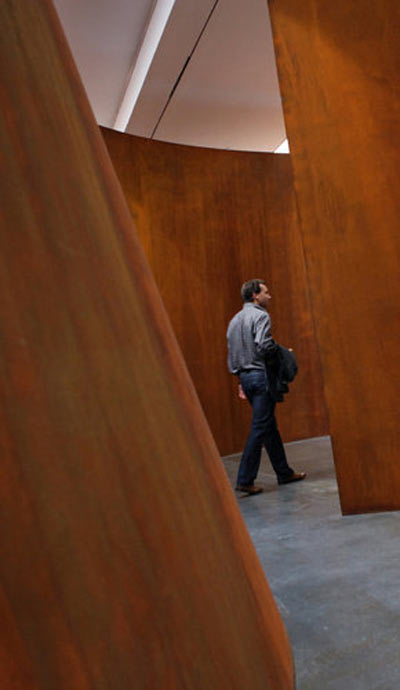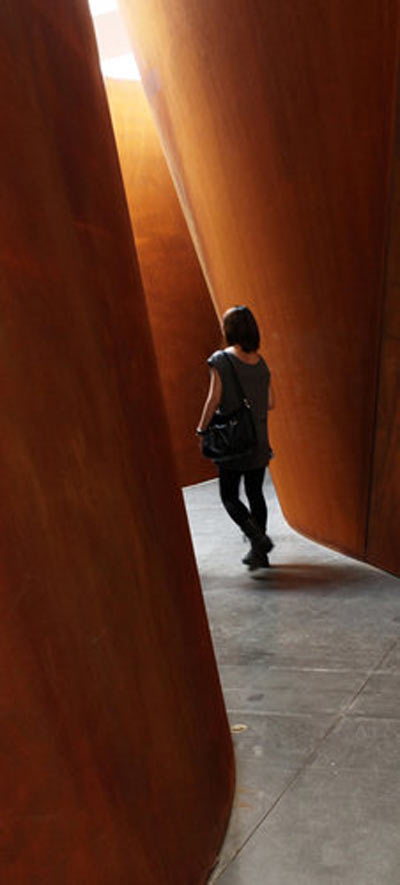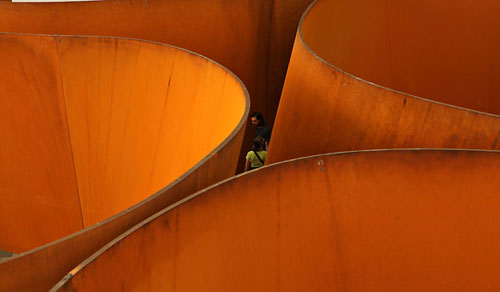
 Sculpture News at SculptSite.com
Sculpture News at SculptSite.com
Richard Serra Sculpture |
| TheNewYorkTimes By KAREN ROSENBERG Shockingly Orange, Invitingly Meandering, Immensely ImposingAt 71 the indefatigable sculptor Richard Serra is making some of the most intensely visceral work of his career. His latest sculptures in weatherproof steel are big enough to test the boundaries of the immense Gagosian Gallery on 24th Street in Chelsea, though their power has less to do with their sheer magnitude than with the way they carve up the space. The show is Mr. Serra's 12th sculpture exhibition at Gagosian, and his best in New York since a 2007 retrospective at MoMA. A touring survey of his drawings, organized by the Menil Collection and seen at the Metropolitan Museum this past summer, opens next month at the San Francisco Museum of Modern Art. His ponderous way with black oil paintstick isn't much in evidence here, except for a single drawing installed in the front window. Nor are the rectangular slabs from his 2006 exhibition at Gagosian, or the boat-shaped labyrinths shown at the gallery's 21st Street location in 2009. Rather, this show, titled "Junction/Cycle" after its two main components, revisits the graceful spirals and ellipses Mr. Serra exhibited here around 2001. Looking at the new work, I felt Mr. Serra, like the rest of us, thinking back to that year. But he's also pushing forward, finding new ways to make one of Chelsea's biggest galleries feel intimate and even claustrophobic with his giant, snaking swaths of steel. He is perhaps the only artist who is capable of doing so. The two sculptures at Gagosian almost fill the rooms that house them. "Cycle" measures 57 feet at its longest point, "Junction" 75 feet; they are 14 and 13 feet high, with "Cycle" nearly brushing the front gallery's ceiling trusses. Together they weigh 441 tons. Yet they're nimble, exquisitely responsive to each other and the space around them. "Cycle," when seen in an overhead photograph, looks like a loosely-wound Celtic triple-spiral. "Junction" has four curved arms that branch out from a central node. But I recommend consulting these images only after you've walked through the sculptures, so that you are effectively mapless. This is important because the works are essentially mazes. In a rare move Mr. Serra is giving you options. There are many ways through the sculptures, some of them more circuitous than others but all of them equally valid. The first piece you will encounter is "Cycle," just past the reception desk. Almost immediately upon slipping into its metallic embrace you are forced to make a choice. One path dead-ends, leaving you in an elliptical enclosure; the other leads you along a slim, winding channel where you will be presented with more choices. It's as if Mr. Serra had deconstructed one of his "Torqued Ellipses," turning a single journey to the center into two discrete experiences. This accounts, partly, for the sensation of time splitting. Fellow travelers, muttering, "Left or right?" or "Did we walk this way? I think so," appear and reappear. Eventually you'll emerge into a corner of the gallery, feeling thoroughly discombobulated. The entire passage brings to mind a hike through a redwood forest, especially when the ruddy ribbons of weathered steel nearly converge overhead. It can be very dark in there, and lush; even though you can hear the buzz of fluorescent light fixtures, they seem to be miles away. Mr. Serra would probably resist being called a landscape artist, but "Cycle" has more than a touch of the sublime. "Junction," the second and more expansive sculpture, reinforces that notion with great, velvety sweeps of metal that have been patinated to a rich pumpkin hue. The color is unexpected; apparently the sandblasted steel has only begun to oxidize, so it looks lighter and brighter than the material in Mr. Serra's last couple of shows. In places you can see a leaf pattern where tree branches brushed the steel plates as they were en route to the gallery; they had been loaded onto trailers but were delayed by Hurricane Irene. Once you're between those plates, you feel a tremendous surge. "Cycle" offers clearings, where you can pause and collect yourself. But the blind curves of "Junction" propel you through and, before you know it, spit you out. The movement feels akin to surfing, or being whooshed through a system of pneumatic tubes. The relationship between the two sculptures is endlessly fascinating. You might see "Cycle" as a contracted version of "Junction," a figure skater in spin mode. Or you might see "Junction" as the extrovert to "Cycle's" introvert, with its four arcs that open wide to face the gallery walls. Either way, you'll start to see around, under and behind the tons of steel that went into these works, to understand what Mr. Serra means when he says, "I consider space to be my primary material." |
 I so agree with Mr. Serra when he says "I consider space to be my primary material." Richard Serra surely ought to know! I am not a sculptor, but a devotee of sculpture and I have always thought SPACE to be a pivotal ingredient to sculpture of most all types. If there is a way for one to get to New York to experience this incredibble exhibion of sculpture (space) by Richard Serra, please do so! Gagosian Gallery is an awesome gallery space as well! A very nice read by New York Times writer KAREN ROSENBERG! "Junction/Cycle" continues through Nov. 26 at Gagosian Gallery, 555 West 24th Street, Chelsea; (212) 741-1111, gagosian.com. |
 |
| A gallerygoer is swallowed by the undulating wall of metal as he follows the metallic trail of "Cycle." Julieta Cervantes for The New York Times |
 |
| At some points "Cycle" nearly touches the ceiling of the gallery. Julieta Cervantes for The New York Times |
 |
| A view from above "Junction," Richard Serra's sweeping sculpture of oxidized-metal curves, at Gagosian Gallery. Julieta Cervantes for The New York Times |
More Sculpture News ....
Submit your SCULPTURE NEWS.
It's easy, just send us an e-mail
(click on Submit News in the left menu) with your pertinent information along with images, we'll take care of the rest. Sculpture makes our world a much better place in so many ways!
SculptSite.com, along with Sculptors and their creative genius all helping to bring the beauty and message of Sculpture to a hurried world.

